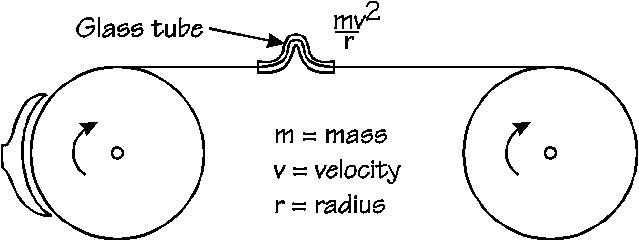
The following originally appeared in the July, 1994, issue of the Bulletin of the Southern California Association of Violin Makers. Dr. Norman Pickering has been a regular at SCAVM Symposiums since 1987. He is a past president of the Violin Society of America and founder of Pickering and Co. He is the inventor of the phonograph reproducer which was the basis of the company's business. He also played French horn and viola with the Metropolitan Opera for fifteen years and was technical consultant to George Szell, Cleveland Symphony Orchestra.
Editor's Note: As originally published, this article erroneously attributed the whistle on the E string to longitudinal vibration rather than torsional vibration. This has been corrected in this version. The statement on string whistling has been deleted from the fourth paragraph following Figure 5, reworded, and inserted in the first paragraph after Figure 5. The corrected wording is in blue type. If you have the print version that was included with the July 1994 Bulletin, please make the correction there as well. Please accept our apology for the error.
Dr. Norman C. Pickering, our featured presenter for this topic, made what he considers his first good instrument, a viola, 47 years ago. He is an engineer, a musician, and a physicist. He has developed equipment for sound reproduction, including microphones, and is now a consultant in musical acoustics. Since 1948 he has made an average of one instrument a year. The puzzle of why some instruments turned out well and some didn't led him to delve into violin acoustics. Despite his having a fine acoustic laboratory through which he expected a quick solution he found it wasn't easy.
Exploring the acoustics of stringed instruments involves not only the physics of vibrating bodies, but also the psychoacoustics of human bodies. We must never forget that a violin is made to be played by a human being and that human being is a very important part in the total equation. We are dealing with a system that consists of, besides the player, the bow and the instrument. We must not overlook the importance of the bow. For music purposes the bow is more important than the instrument. The bow technique is what makes the music. Norman quoted one of his teachers as saying that the left hand makes the notes but the right hand makes the music.
Norman sees very little correlation between the electronic tuning of free plates and the result when the instrument is glued together. The finest contemporary instruments that he has seen were not made using this technique. Their makers adjusted their plates using tapping, flexing, and light transmission. These makers do have highly trained ears, however, that are sensitive to certain parts of the spectrum. With wood of proven quality he has seen excellent instruments made working only to dimensions with some final touchup such bridge and post adjustments and some scraping on the outside.
We must not be afraid of making instruments too light, although we should avoid the extremely thin plates that produce a tubby sound. Norman's attempts at making instruments as light as possible still result in instruments a few grams heavier than most fine Italian instruments. Remember, these have lasted over 200 years without collapsing and have powerful sound. The plates are typically about a half millimeter thinner than contemporary plates. A lightweight structure is easier to get into vibration and easier to get out of vibration. A musician, of course, is constantly doing both of these: starting and stopping notes.
A major contribution to the final result is the initial wood treatment. The first thing you put on the wood has the greatest effect. Succeeding coats have less and less effect on the total quality. Norman stated that the first coat should stiffen the wood, especially across the grain of the top wood. Stiffen means to increase the ratio of stiffness to mass. In the process you raise the resonant frequency of the tap tone. Top wood, which is quite absorbent, will noticeably stiffen when treated by a number of materials. In so treating, the transverse velocity of sound will more nearly match the longitudinal. In some spruce the ratio before treatment may as high as 12:1. After treatment this may change to 3:1 or 4:1. Norman has found lacquers and thin solutions of reasonably stiff resins to be effective, and make a great deal of difference in the finished instrument.
The radiated sound field of an instrument is extremely complex. Many players erroneously believe that most of the sound of an instrument comes out of the f holes. Actually, just as much sound radiates from the back as from the top. Obviously the player does not have the same perspective on the sound he is producing as a listener would have. A few feet away and you hear the sound that radiates from all parts of the instrument and all parts do indeed radiate. The player hears mainly the sound from the top. The complex sound field of a violin is not the same close to the top as it is say two feet or 50 feet away. This is why players cannot always judge what their instruments sound like.
The broadest spectrum of sound comes from the top, but the back fills in some important holes. Also, it cooperates with the top, especially in the mid frequency range. When the plates vibrate thus:
<( )>
they produce more sound than
>( )> or >( )|.
Norman feels that cooperation between the top and back plates at the mid frequencies is the principal key to making a good instrument.
Norman believes that the mysterious quality called carrying power comes from the cooperation between the plates in the midrange at about 500 Hz. The good instruments have a powerful focused sound with high intensity fundamentals in this range. The audience hears much more of the back radiation than does the player. A player may have two violins that sound equally loud to him, but if one is putting out more back radiation in this midrange the audience will hear it as a more powerful instrument. He feels that Bill Fulton's violin made with bent plates (the one Bill brought to the Symposium) has this quality of cooperation between the plates.
Norman also feels that the criticality of the soundpost location
is not so important as commonly supposed. He does feel that the
fit of the soundpost is important. A poorly contacting post, perhaps
having a half moon contact, will in a few hours of playing imbed
itself into the plate resulting in a different relationship. Or
it may never really settle in.
For proper fit a small lateral movement of a soundpost will necessitate
the making of a new post. A little more longitudinal movement
is possible without making a new one.
A good violin will have a peak in its response at around 500 Hz. A lesser violin may have two peaks. Often the two peaks can be moved together by adjusting the post, but if they are widely separated this won't be possible. In this case you will need to regraduate the plate having the higher frequency peak (remove wood, usually a very small amount near the two ends).
The best old violins have a very sharp cutoff above approximately 5 kHz that is not found in modern violins. Unfortunately, Norman doesn't know of any treatment through which it is possible to make a violin with this characteristic although he feels it involves treatment of the wood, either by age or other means, that causes higher damping at higher frequencies but leaving plenty of power at the lower frequencies.
The bridge is the dominant element in voicing an instrument. It has its greatest effect in the high frequency region, acting as a low pass filter with a sharp peak before cutoff. The peak in this region, which is above the highest fundamental note, gives a violin brightness.
Thinning the bridge can help give the desired high frequency rolloff. This is because, as wood is removed, stiffness diminishes faster than does mass. Thick bridges tend to be harsh and overbright because they transmit the higher frequencies better than do thin ones. This is because of this greater stiffness.
Norman reports that about 30 years ago he treated an instrument with linseed oil, as recommended by Joseph Michelman in his book Violin Varnish and achieved a high frequency rolloff similar to what he was seeking. He also mentioned that in the Long Island, New York, climate it took about six months for the linseed oil to dry.
Norman has never seen any confirmation of the notion that instruments need to broken in. In the hands of a good player an instrument does improve, but he attributes this partly to improvements in setup, such as soundpost, string height, bridge adjustment, string selection, bow selection, etc., but mainly to the adaptation of the player to the instrument. In making measurements on instruments that have been fully stabilized (glue and varnish thoroughly dry, etc.), but not played, he hasn't been able to find any changes after this break-in period. He's likewise used devices for electro-mechanically exciting instruments for hundreds of hours and found no changes in tone or playability afterward.
Norman finds that different bows make a difference in tone on a given instrument. Bows have resonances as do instruments and can be matched or unmatched to instruments The matching process is much too complex to be done with instrumentation and must be done by a player.
To complicate matters, resonances of both bows and instruments change with climate, although bows are more stable than instruments. This accounts for instruments that sound better in summer than in winter, or vice versa.
Norman does not believe listening tests are valid. He told of a recent occasion when the well-known violinist, Pinchas Zukerman, played a number of dissimilar violins in his laboratory. To Norman the instruments all sounded alike. But it was only because this highly skilled player was able to make them sound alike: the way he wanted them to sound through adjustments in bow speed, bow pressure, etc. To Mr. Zukerman the good violins were the ones that responded most easily: those that he was able to play with the least effort.
On another occasion, during a 5 day test at Brigham Young University, he gave 5 skilled players 25 instruments, all of good to excellent quality, and asked to rate them in order, taking as long as they needed. They were able to agree on the 5 lowest and on the 5 or 6 highest, but were never able to rate the top instruments in order—they couldn't agree among themselves and their choices would vary from day to day. An audience listening to these instruments and asked to judge them rated them totally at random.
Norman began his presentation on How the Bow Produces Sound from a String with a thought experiment conceived about 50 years ago by Philip Morse, a Professor of Acoustics at Harvard, to explain a little bit about how strings work. Refer to Figure 1.

Assume that there is a practically unlimited length of string on the left reel. You are able to wind the string to the right reel at a variable speed under a controlled tension, which is applied through the brake on the left reel. This is analogous to tightening a string. The kink in the middle represents a glass tube with the string passing through. We run the string at gradually increasing speeds through the glass tube. As the speed increases it will reach a point at which the centrifugal force equals the tension. At this point you could break the glass tube and the kink would remain. The centrifugal force formula is given in the figure. Of course in a real string it's the kink that moves lengthwise rather than the string . When we see a plucked string vibrating we see something that looks like the outside envelope in Figure 2. What is really happening, however, is that a kink is traveling back and forth—actually there are two traveling in opposite directions and they extend to the outer envelope in the figure. It is possible to stop the string with high speed photography and see the kinks.

The bowed string works differently. The string vibrates in a sawtooth pattern as illustrated in Figure 3.
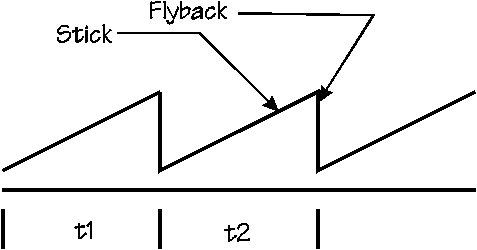
To date the best bowing material is the combination of natural horsehair and rosin. Contrary to popular belief there are no barbs or ridges on horsehair: it's smooth and shiny.
Rosin breaks up into tiny particles with sharp edges. There's an ionic interchange between the collagen in the horsehair and the rosin resulting in a mutual attraction between these two complex molecules somewhat like static electricity. During bowing the particles of rosin get trapped between the string and the bowhair.
Bowing heats the rosin. Rosin's static coefficient of friction rises steeply as the temperature rises from say 50° F to 90° F at which point it becomes very sticky. At the same time the slipping coefficient drops off, so the gap between stick and slip increases as indicated in Figure 4. The temperature at which it is operating is critical to the amount of force. You are momentarily gluing the bowhair to the string and it tends to move the string over. Eventually it reaches a point where the tension of the string breaks it loose. This starts the first oscillation. When that starts, the waves traveling back and forth on the string begin. The peaks coming back to the bow tend to snap the string loose and you get a succession of waves (stick and flyback in Figure 3). This is the movement that drives the bridge to eventually produce the sound you hear.
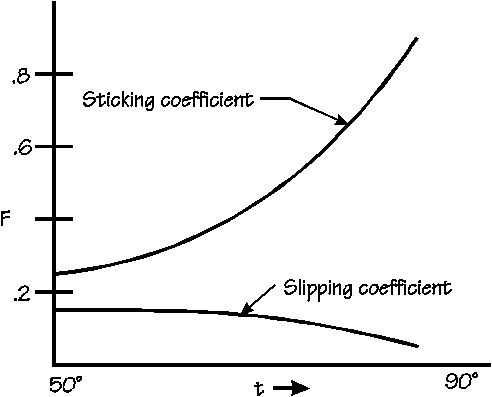
Norman debunked the notion that bowhair wears out. He repeated
that there are no barbs or hooks on bowhair to wear off despite
what some musicians or teachers may tell you. It is not necessary
to rehair a bow until too many hairs have broken off. He knows
of professional players who have used the same hair for 20 years.
If the hair gets dirty, the bond between the horsehair and the
rosin diminishes. You can then clean the hair to its initial condition
and it's as good as new.
The application of the bow at the perimeter of the string results
in a more complex vibration, however. Referring to Figure 5, since
the mass of the string is effectively at the center, there will
be some rotation of the string during bowing.
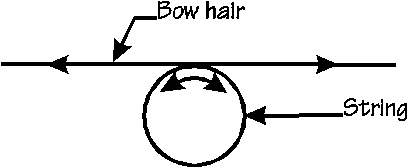
Strings have three modes of vibration. The first is the desired lateral vibration of Figure 2. The second is the torsional or rotating mode. The torsional frequency is very low and not related to the musical frequency. Because of this, strings with insufficient torsional damping will cause problems because the string, at the sticking time in its lateral cycle may be at a point in its torsional cycle where it does not want to stick. The process must wait until the torsional cycle gets to the point where the hair can stick. The result is a variation in frequency and in amplitude. There is less of this problem close to the bridge where the string is harder to rotate. There is also less torsional vibration in small diameter strings than in large diameter strings. You can observe the torsional vibration of a string by lightly cementing a cat's whisker to it close to the bowing point. Watch what happens when you reverse the direction of the bow. The most familiar example of torsional vibration is the whistle on the solid steel E string.
Gut, Perlon, and metal core strings can all be made for use at various tensions and there is no truth to the notion that steel strings always have higher tension than the others. In fact some gut strings have higher tensions than some steel strings. It all depends on what the designer wanted.
The advantage of steel strings is the small diameter and the stability. Fine tuners of course are required because of the low elasticity. Gut strings have the virtue of high damping.
The third vibrational mode is the longitudinal mode. This consists of compression waves that go from one end of the string to the other. This is not a problem with gut and Perlon strings because of their high damping. It is a problem with steel strings, however. It is dealt with by making the core of the string from a bundle of very fine wires rather than a single larger wire. The bundle can be impregnated with a long chain polymer which acts as a damping material.
An advantage of plain gut is that is a poor conductor of heat. With a cold bow and a cold string it will take some time to develop a tone. However, bow hair heats up quickly. Solid gut strings are similar in this regard. Metal strings, however, will conduct heat away rather rapidly and will be harder to get started. This is one reason why a gut E string is easier to play than a metal one, especially when playing close to the bridge. A disadvantage of a gut string is its instability with regard to humidity, and its softness.
There are only two ways to increase string drive. One is to
move the bow faster; the other is to move the bow closer to the
bridge. Pressing harder on the bow does not increase the output;
it flattens the note and gives a slight increase of high frequencies
which gives the illusion of more output to the player.
Good players play close to the bridge with a slow bow: a slow
bow does not conduct the heat away as quickly as a faster bow.
Metal windings on strings are for weight. Silver is the preferable winding because of its greater weight versus aluminum, although it is too heavy for A strings. This results in a string with a smaller diameter. Gold, because of its greater weight, would be better for G and C strings but it's expensive. Copper is not suitable because it corrodes readily. Tungsten is massive, but it's not ductile and therefore difficult to wind tightly.
Norman stated that the tailpiece assembly has a low resonance and its length is not critical. The silk wrapping on the ends of the strings are there to dampen them.
The bridge also must move to transmit sound. Norman used Figure 6 to illustrate the effect of this. The string passes over the bridge at A. If the bridge is moving in phase with the string the string will seem longer, as though the bridge were at C, and produce a lower note. If the string and bridge are vibrating out of phase with each other, the effect will be as though the bridge were located at B.
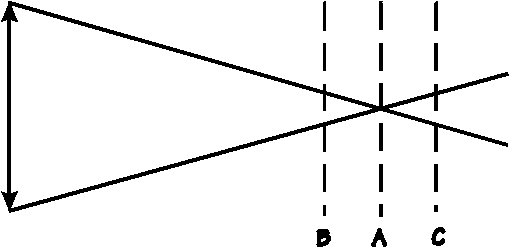
Fingerboard tuning gives the illusion of power if it is at a major resonance. However it is actually drawing power from the body of the instrument. The shaking makes the player feel that more power is being produced, but it is not reaching the airborne sound.
Norman concluded his presentation by giving some tips on the construction of a small viola: as the instrument is scaled down, the size of the f holes should be increased. Also, use larger diameter strings to maintain reasonable tension at shorter playing lengths.
All Bulletin articles are copyrighted ©1998 by the Southern California Association of Violin Makers. Contact Bulletin editor John Gilson, at the address given on our home page, for permission to reproduce Bulletin material.
Return to home page of the Southern California Association of Violin Makers